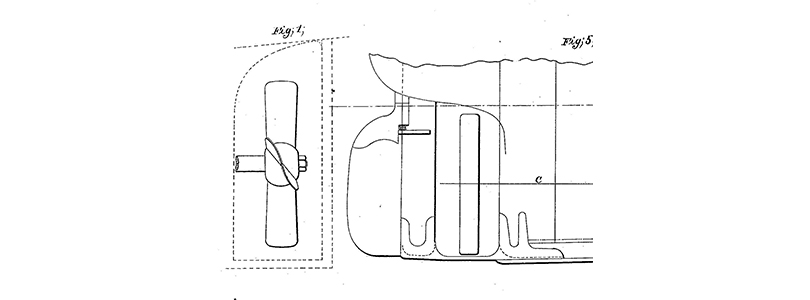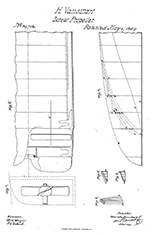Content
Henrietta Vansittart

US89712
In the name of the father
Her name was almost forgotten, but today Henrietta Vansittart has a firm place in the history of technology: she was one of the first women in Europe to work publicly as an engineer and inventor. Henrietta Vansittart, née Lowe, even achieved a certain fame in her time. Her ship's propeller is considered an important nautical invention of the 19th century.
Henrietta, probably born in Surrey in 1833, was one of the six children of the blacksmith and inventor James Lowe. She grew up in poor circumstances. Her father invested his wife Marie's money in his tinkering with a screw propeller, for which he received a British patent (No. 7599) in 1838. The invention probably had some success. But Lowe apparently found himself forced to fight several legal battles over the infringement of his patent, which eventually brought him to the brink of ruin.
Henrietta must have acquired her profound knowledge of technology in general and marine propellers in particular, which she later demonstrated, from her father, because she never received any formal training. It is documented, for example, that she accompanied her father on board the small warship "HMS Bullfinch" in 1857 to test his latest propellers.
A bereavement as an incentive
By 1855, Henrietta Lowe had already married the dragoon lieutenant Frederick Vansittart. The turning point of her life, however, was the accidental death of her father on 12 October 1866 (he was run over by a carriage in London). She decided to continue his work. She worked as an engineer for almost two decades, becoming much more successful and well-known than her father and decisively improving the Lowe-Vansittart propeller.
In 1868, she was one of the first women to receive a British patent in her own name (No. 2877). A US patent followed in 1869 ( ![]() US89712A). Her improved propeller (with curved instead of straight blades) was said to be faster, more efficient and less subject to vibration than its predecessors; it was also more controllable in reverse. It was used in various naval and merchant ships, for example in the "HMS Druid" in 1869. A model of the propeller, which Vansittart donated to the house, can still be found in the
US89712A). Her improved propeller (with curved instead of straight blades) was said to be faster, more efficient and less subject to vibration than its predecessors; it was also more controllable in reverse. It was used in various naval and merchant ships, for example in the "HMS Druid" in 1869. A model of the propeller, which Vansittart donated to the house, can still be found in the ![]() Science Museum London.
Science Museum London.
Internationally honoured
The Vansittart propeller received a number of international awards between 1872 and 1881, including medals and diplomas at exhibitions in Dublin, Paris, Sydney, Melbourne and Adelaide. Henrietta gained respect and reputation in professional circles. In 1876 she wrote and illustrated a scientific article on the Lowe-Vansittart propeller, which she presented in person at the Association of Foreman Engineers and Draughtsmen in London in 1880 - the first woman ever to do so, it is said.
In 1882, Vansittart published "The History of the Lowe Vansittart Propeller and a short extract of the life of the late Mr James Lowe, the successful inventor of screw ships from their first introduction", in which she paid tribute to her father's legacy.
All for the family?
In fact, Vansittart, who was later hailed as a pioneer of emancipation, had, in her own words, only stepped out into the men´s world of science and business to honour and continue her father's work. Officially, she stated that a woman's place was actually at home with the family - unless it was to defend the cause of a family member, as in her case. Whether she really thought that way or was just pretending to be on a mission to avoid being antagonised by the Victorian male world will probably never be known.
So it was her mission in the name of the father that made her a successful engineer, respected by the public as an inventor and expert in ship propellers, and even recognised by the Admiralty and naval engineers. But whatever her motivation, she confidently transcended established gender roles and, thanks to her qualifications, won her place in a world that was virtually inaccessible to women at the time.
A private life less ordinary, too
That Vansittart was a courageous woman indeed was also evident in her unconventional private life. As early as 1859, she had begun a love affair with the (married) politician, writer and baron Edward Bulwer-Lytton (his best-known book is probably "The Last Days of Pompeii"). Vansittart left her husband and henceforth lived in her grandfather's house in Ewell. She received financial support for her work from her prominent lover. The affair, which must have lasted 12 years, was well known in both families and even in Parliament. When Bulwer-Lytton died in 1873, he bequeathed a considerable sum of money to Vansittart - and some to her husband, too!
Henrietta used it to buy houses in Twickenham, but is said to have later failed to pay the maintenance fees on her patent.
The life of this pioneer ended sadly: after visiting a technology exhibition in Tynemouth, she was taken into custody on the street in September 1882, allegedly confused and conspicuous by aggressive behaviour, and admitted to St Nicholas's Hospital in Gosforth (according to other sources it was the Tyne City Lunatic Asylum). She never left it again. 140 years ago, on 8 February 1883, she died there, officially due to "mania and anthrax".
Text: Dr. Jan Björn Potthast; Pictures DEPATISnet, Public domain / via Wikimedia commons, Trustees of the Science Museum Group/Science and Society Picture Library, André-Adolphe-Eugène Disdéri / Bibliotheque National de France / Public domain via Wikimedia commons
Last updated: 16 April 2025





Not only protecting innovations
Social Media